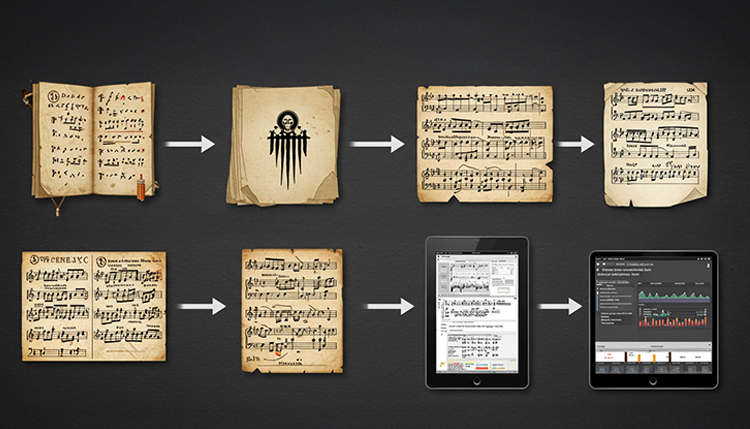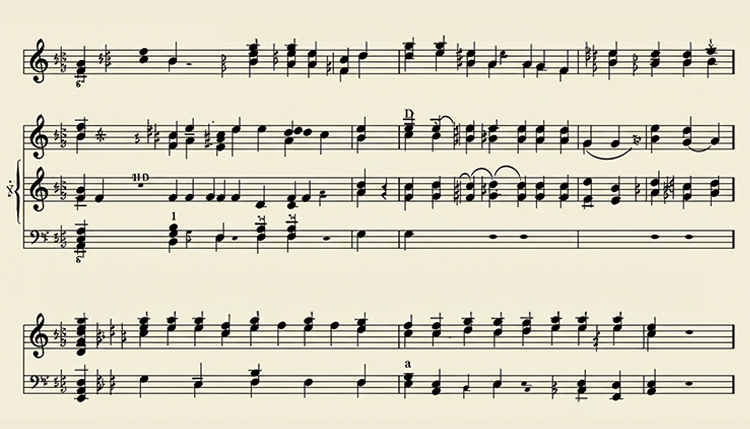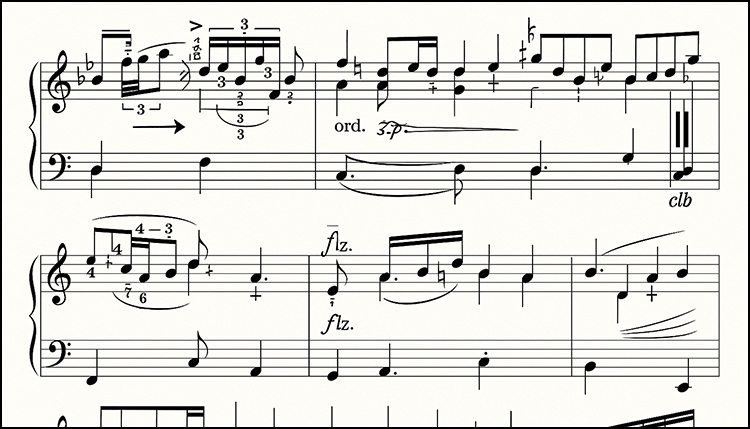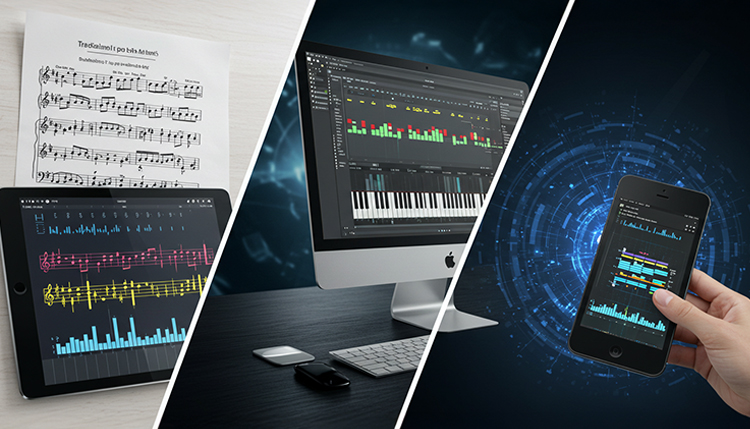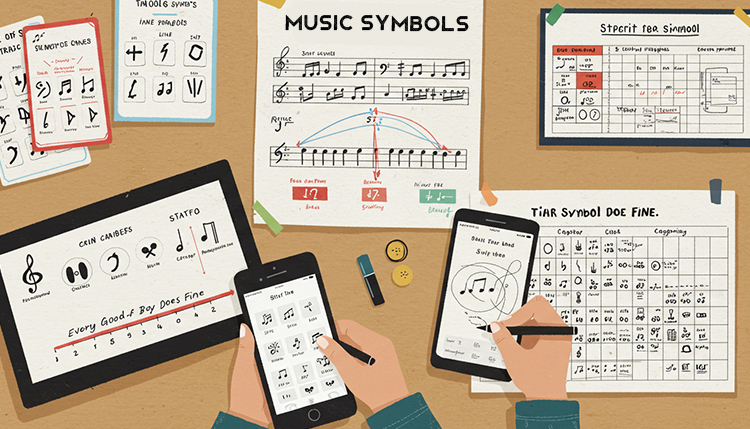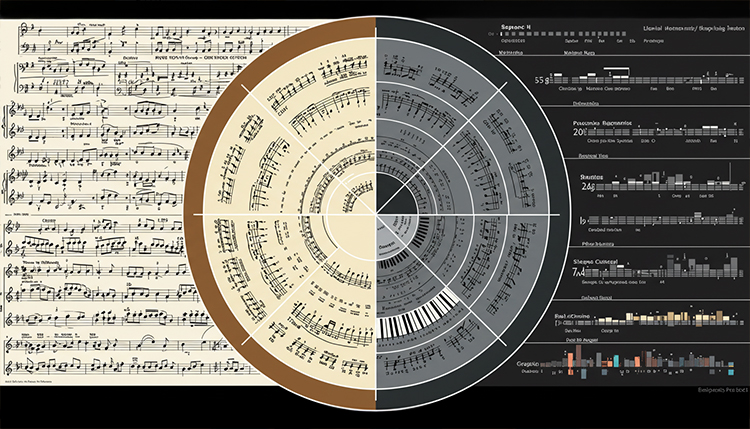Table of Contents
From the elegant curves of a treble clef to the mysterious dotted markings that shape our musical experience, music symbols are the visual language that has connected musicians across centuries.
These tiny visual cues might seem insignificant to the untrained eye, but they’re actually the DNA of musical communication.
Without them, we’d be stuck trying to explain music with words alone—talk about a buzzkill for composers!
Most beginning musicians cite symbol recognition as their biggest challenge when learning to read sheet music.
Our extensive library of 200+ music symbols will help demystify everything from basic notes to advanced performance directions, covering essential categories like rhythmic notation, dynamic markings, articulation symbols, and specialized instrument directions.
The Evolution of Music Symbols
The story of music notation is basically a thousands-year-old group project that nobody could agree on for centuries.
Musical notation didn’t just appear out of thin air—it evolved from crude scratches to the sophisticated system we use today.
Early musicians were straight-up winging it, relying on memory and oral tradition to pass down melodies.
The earliest notation systems were pretty sus by today’s standards, with neumes (those squiggly marks above text) giving only a rough idea of melodic shape without precise pitch or rhythm.
Medieval monks deserve major props for developing the first staff lines around the 10th century, finally giving musicians a reliable way to indicate specific pitches.
By the Renaissance period, notation started looking more familiar, with standardized note shapes indicating duration and pitch relationships that modern musicians would recognize.
The printing press was a total game-changer for music notation, allowing for mass distribution of consistent symbols and accelerating standardization across Europe.
Composers kept tinkering with the system, adding new symbols as musical complexity increased—Bach’s era saw ornaments flourish while Beethoven pushed dynamic markings to new extremes.
Jazz musicians in the 20th century were like, “we need our own vibe,” developing chord symbols and slash notation that communicated the essential framework while leaving room for improvisation.
Digital notation software has revolutionized how we create and share music, though the core symbols remain remarkably similar to those used centuries ago.
The most fascinating aspect of music notation is how it balances precision with interpretive freedom—some markings are mathematical in their exactness while others deliberately leave room for artistic expression.
Different cultural traditions developed their own unique notation systems—Japanese gagaku notation uses completely different symbols, while Indian classical music employs its own specialized notation for ragas and talas.
- Staff notation conquered the world alongside Western classical music, becoming the dominant international standard
- Early notation was more about reminding performers of melodies they already knew rather than teaching new ones
- The five-line staff we use today wasn’t standardized until around the 16th century
- Tempo markings were originally just casual Italian instructions before becoming codified terms
- The standard treble clef evolved from an ornate letter G that marked the G line on the staff
Notation technology keeps evolving, but the core principles have remained surprisingly stable.
Today’s music apps and software can display traditional notation alongside guitar tablature, MIDI information, and even audio waveforms—a fusion of old and new symbolic languages.
Some contemporary composers have pushed notation to wild new frontiers, inventing completely new symbols for extended techniques or graphical scores that look more like abstract art than traditional sheet music.
Despite predictions that standard notation would become obsolete in the digital age, sight reading remains an essential skill for professional musicians across genres.
The evolution of music symbols reflects our ongoing quest to capture sound on paper—an impossible task that we’ve gotten surprisingly good at over the centuries.
Essential Music Symbols for Beginners
Let’s get real—facing a page of sheet music for the first time feels like trying to decode an alien language.
The staff is home base for all music notation—those five horizontal lines and four spaces where notes live, each representing a different pitch in the musical alphabet.
Clefs are the gatekeepers that tell you which notes live on which lines, with the treble clef (that fancy G-shaped swirl) handling higher notes while the bass clef (the backwards C with two dots) takes care of the low end.
Beginners often get the heebie-jeebies when first encountering ledger lines—those tiny extra lines that extend the staff when notes go too high or low.
Notes and rests form the basic vocabulary of rhythm, with different shapes indicating how long to play or not play—whole notes get four beats, half notes get two, quarter notes get one, and so on down to sixteenth and thirty-second notes that zip by in a flash.
Time signatures are like the musical equivalent of speed limits, with that fraction-looking symbol telling you how many beats are in each measure and which type of note gets one beat.
The 4/4 time signature is so common it’s nicknamed “common time” and even has its own symbol (C), while 3/4 gives us the waltz’s distinctive one-two-THREE feel.
Key signatures might look like a random scattering of sharps or flats at the beginning of the staff, but they’re actually a super efficient way of saying “these notes are automatically sharp or flat throughout the piece, so I don’t have to keep writing the symbols over and over like a chump.”
Accidentals (sharps ♯, flats ♭, and naturals ♮) temporarily raise or lower a note by a half-step, overriding whatever the key signature says for the rest of the measure.
Dynamic markings give music its emotional juice, with pianissimo (pp) whispering secrets while fortissimo (ff) shouts from the rooftops.
Bar lines slice music into digestible chunks called measures, making it easier to practice, count, and coordinate with other musicians.
Repeat signs are the musical equivalent of “rinse and repeat,” saving composers tons of ink when they want sections played multiple times.
- Learning to read note values is like learning multiplication tables—painful at first but eventually automatic
- The mnemonic “Every Good Boy Does Fine” helps remember the notes on the treble clef lines (E, G, B, D, F)
- The spaces in the treble clef spell “FACE”—how convenient is that?
- Bass clef lines are remembered with “Good Boys Do Fine Always” (G, B, D, F, A)
- Most beginners find rhythm more challenging than pitch when learning to read music
Double bars mark major sections in music, like musical chapter breaks letting you know something significant is changing.
First and second endings are the choose-your-own-adventure of music notation, telling performers which path to take during repeated sections.
Slurs connect notes that should be played smoothly together without rearticulating, while ties connect notes of the same pitch to add their durations together—mix these up at your own peril.
Basic articulation marks like staccato dots (play short and detached) and accent marks (give extra emphasis) are like punctuation in written language, adding clarity and expression.
Once you’ve got these basics down, you’ll be shocked at how quickly your musical literacy improves—the difference between week one and week twelve of consistent practice is mind-blowing.
Intermediate Music Symbols and Notations
Leveling up your music symbol game is like unlocking the secret menu at your favorite restaurant—suddenly you’ve got way more options for expression.
Articulation markings are basically the punctuation of music, giving performers specific instructions about how to attack and release notes.
Staccato (those little dots above or below notes) tells you to play short and detached, like musical hiccups that create space between notes.
Legato (curved lines connecting different notes) is the opposite vibe, instructing smooth, connected playing with no gaps between sounds.
Tenuto (horizontal lines above or below notes) asks for full value or slight emphasis, holding the note for its complete duration or a touch longer.
Marcato (those little hat-shaped accents) demands maximum attack and emphasis, like the musical equivalent of typing in ALL CAPS.
Ornaments were the original musical flex, allowing performers to show off their technical chops with decorative flourishes around the main notes.
Trills (tr with a wavy line) require rapidly alternating between two adjacent notes, creating a shimmering, energetic effect that can range from elegant to frantic depending on the tempo.
Mordents (those squiggly horizontal symbols) are like mini-trills, quickly dipping to the note below (or above for an inverted mordent) and returning to the main note.
Turns (that sideways S symbol) instruct players to execute a quick four-note pattern around the written note, adding graceful motion to a melody.
Tempo markings are mostly in Italian because Italian composers were crushing it back when notation was being standardized—terms like allegro (fast), andante (walking pace), and adagio (slow) give performers a general speed range.
Metronome markings get specific with the beats per minute, leaving no room for interpretation with precise instructions like ♩= 120.
Fermatas (those bird’s-eye symbols) tell performers to hold a note or rest beyond its normal duration, often for dramatic effect or to allow for a brief cadenza.
Dynamics don’t just include the basic p (piano/soft) and f (forte/loud), but also include hairpin crescendo and diminuendo symbols showing gradual volume changes.
Advanced dynamic markings like sforzando (sfz) call for sudden emphasis on a single note, while fortepiano (fp) demands an immediate drop from loud to soft.
- Rhythm dots after notes increase their duration by half (a dotted quarter note equals a quarter plus an eighth)
- D.C. al Fine instructs performers to go back to the beginning and play until they reach “Fine”
- D.S. al Coda tells musicians to jump to the sign (§), then play until directed to the coda (⊕) section
- Grace notes (those tiny notes with slashes) are played quickly before the beat, “stealing” time from the main note
- Triplets fit three notes into the space normally occupied by two, creating a distinctive galloping rhythm
Slurs and ties look similar but function completely differently—ties connect the same note across bar lines or beat divisions, while slurs indicate phrasing for different notes.
8va (or 8vb) markings save composers from writing excessive ledger lines by indicating that a passage should be played an octave higher (or lower) than written.
Breath marks (those little commas) give wind and vocal performers permission to breathe, preventing that awkward gasping sound mid-phrase.
Rehearsal letters or numbers are like musical GPS coordinates, letting conductors say “let’s start at letter B” instead of “let’s start at measure 47.”
Understanding these intermediate symbols transforms your musical reading from robotic to expressive, letting you access the emotional intentions behind the notes.
Advanced Music Symbols for Professional Musicians
Pro-level music symbols are where things get seriously spicy, separating the casual players from the conservatory crowd.
Complex time signatures like 7/8 or 5/4 throw rhythmic curveballs that keep performers on their toes, creating that “wait, where’s the downbeat?” feeling that makes contemporary music so engaging.
Polyrhythms—notated with nested tuplets or brackets—create multiple simultaneous rhythmic layers, like playing in 3/4 and 4/4 at the same time (total brain-bender).
Metric modulation symbols show precise tempo relationships between sections, using mathematical ratios to ensure smooth transitions when the beat value changes.
Feathered beaming (those note beams that get progressively closer or further apart) indicates accelerando or ritardando within a single gesture, visually displaying the speed change.
Contemporary notation has invented wild new symbols for extended techniques like multiphonics on wind instruments (producing multiple pitches simultaneously) or col legno battuto (hitting the string with the wood of the bow).
Microtonal accidentals go beyond the standard half-step to indicate quarter-tones, eighth-tones, or even more precise pitch divisions—Western notation playing catch-up with musical traditions that never limited themselves to just 12 pitches per octave.
Aleatoric notation gives performers controlled freedom, with symbols indicating improvisation within specific parameters—a composer’s way of saying “surprise me, but not too much.”
Graphic notation breaks free from traditional symbols entirely, using visual shapes, lines, and textures to inspire more interpretive, improvisational performance.
Specialized string techniques have their own symbol vocabulary—sul ponticello (play near the bridge for a glassy sound), sul tasto (play over the fingerboard for a softer tone), and harmonics (those little circles indicating feather-light finger pressure for bell-like tones).
Percussion notation is its own beast, with hundreds of specialized symbols for different instruments and techniques, often requiring a custom legend for each piece.
- Violin harmonics are notated with small circles above the note, indicating where to lightly touch the string
- Flutter-tonguing (rapid tongue movement creating a tremolo effect in wind instruments) uses a tremolo symbol with a “flz” text directive
- Pedal markings for piano include not just the standard sustain pedal but also una corda (soft pedal) and sostenuto (middle pedal)
- Glissando (continuous sliding between notes) uses wavy lines, while portamento (sliding with more emphasis on start/end pitches) uses straight lines
- Ossia staves provide alternative performance options, often showing easier versions or different interpretations
Metric modulation notation shows precise mathematic relationships between tempos, allowing for smooth transitions that maintain a pulse connection.
Spatial notation abandons traditional measures in favor of proportional spacing, where the horizontal distance between notes on the page represents their temporal relationships.
Cluster notation uses special symbols to indicate playing multiple adjacent notes simultaneously, often with the palm or forearm (especially on piano).
Xenakis and other avant-garde composers invented entirely new notational systems for complex textural music, using geometric shapes and mathematical formulas to indicate sound masses rather than individual notes.
Professional musicians develop an almost instinctive understanding of these symbols, reading complex notation as fluently as you’re reading these words—a superpower earned through thousands of hours of practice.
Digital Music Notation and Modern Symbols
The digital revolution has totally transformed how we create, share, and interact with music symbols.
Notation software like Sibelius, Finale, and MuseScore have democratized music publishing, allowing anyone with a computer to produce professional-looking scores without spending years mastering calligraphy.
MIDI notation introduced new symbolic languages for electronic music, with piano-roll views representing notes as rectangular blocks on a grid rather than traditional noteheads.
Digital scores can now include playback features that traditional paper scores could only dream of, with symbols directly linked to audio samples for instant auditory feedback.
Music XML has become the lingua franca for transferring notation between different software platforms, standardizing how music symbols are encoded and interpreted by computers.
Touchscreen tablets have revolutionized performance, with digital symbols that can change color as they’re played or automatically turn pages when you reach the end of the screen.
Animated notation takes advantage of digital platforms to create scores that transform over time, with symbols that grow, shrink, fade, or morph to convey musical ideas impossible to capture on static paper.
Proportional notation—where horizontal space directly corresponds to time—becomes much more precise in digital formats, freeing composers from the constraints of traditional measures.
AI-assisted notation can now transcribe live performances in real-time, converting audio into music symbols with increasingly impressive accuracy.
Digital symbols can be hyperlinked to explanatory content, allowing students to tap on unfamiliar markings for instant definitions, audio examples, or historical context.
- Digital notation software allows instant transposition with a single click, a task that used to require hours of painstaking rewriting
- Modern scoring programs include specialized symbols for guitar techniques like hammer-ons, pull-offs, and tapping that were poorly represented in traditional notation
- DAW (Digital Audio Workstation) interfaces combine waveform editing with traditional notation, creating hybrid symbolic languages
- Mobile apps can now scan physical sheet music and convert it to digital notation with remarkable accuracy
- Collaborative online platforms allow multiple musicians to edit the same score simultaneously from different locations
Electronic music has developed its own symbolic language, with visualization of parameters like filter cutoff, resonance, and envelope settings becoming standardized across platforms.
Notation for laptop orchestras and other digital ensembles often includes network diagrams and signal flow charts alongside traditional musical symbols, indicating how electronic sounds should interact.
Virtual reality music applications are experimenting with three-dimensional notation, breaking free from the flat constraints of the page to create immersive symbolic environments.
The biggest challenge for digital notation isn’t creating new symbols but standardizing them across platforms so that a score created in one program looks and functions identically in another.
Despite these technological advances, the core music symbols remain remarkably similar to those used centuries ago—a testament to how effectively the traditional system communicates musical ideas.
Learning and Memorizing Music Symbols
Wrapping your brain around hundreds of music symbols is no joke, but there are shortcuts that can save you serious time and frustration.
The human brain learns symbols best through repeated exposure and practical application, so regular sight-reading practice—even just 10 minutes daily—yields better results than cramming for hours once a week.
Flashcard apps specifically designed for music symbol recognition can dramatically accelerate your learning, with spaced repetition algorithms that show you challenging symbols more frequently.
Chunking related symbols together—studying all articulation marks at once, for example—helps your brain create meaningful connections instead of seeing each symbol as an isolated entity.
Mnemonic devices work wonders for remembering note names on the staff, with classics like “Every Good Boy Does Fine” (E-G-B-D-F for treble clef lines) sticking in memory for decades.
Visual learners often benefit from color-coding different types of symbols, creating instant visual categorization that speeds recognition.
Kinesthetic learners should physically draw symbols repeatedly, as the muscle memory of creating the shapes helps cement them in long-term memory.
Most beginners make the mistake of trying to memorize every symbol at once, when focusing on the 20% of symbols that appear in 80% of music would be far more efficient.
Tempo and expression markings in Italian become much easier to remember when you understand their literal translations—allegro means “cheerful,” not just “fast,” giving you an emotional anchor for the technical instruction.
- Associating symbols with specific pieces where they appear prominently creates strong memory connections
- Teaching symbols to someone else forces you to articulate their meaning clearly, reinforcing your own understanding
- Sight-reading duets provides immediate feedback when you misinterpret a symbol, with your partner’s playing highlighting the discrepancy
- Composing your own music using newly learned symbols helps cement their meaning and function
- Listening to recordings while following along with sheet music connects the visual symbols to their auditory results
Most confusion between similar-looking symbols (like the alto clef vs. the tenor clef) can be resolved by focusing on subtle distinguishing features, like exactly which line the symbol centers on.
The hierarchy of symbols helps with quick reading—structural symbols (key signatures, time signatures) set the framework, while interpretive symbols (dynamics, articulations) add expressive detail.
Contextual understanding beats rote memorization every time—knowing that a fermata usually appears at phrase endings or important transitions helps you anticipate where to look for it.
Professionals develop symbol “chunking” abilities similar to how chess masters see the board—not as individual pieces but as meaningful patterns and relationships.
Advanced readers don’t process every symbol individually but take in entire musical “sentences” at once, recognizing familiar patterns and focusing attention only on unusual or complex markings.
Music Symbols in Different Genres
Music symbols aren’t one-size-fits-all—different musical traditions have developed their own unique symbolic languages.
Classical notation reigns supreme in precision, with every nuance meticulously marked to ensure the composer’s intentions survive across centuries and performers.
Jazz charts take a more chill approach, often showing just chord symbols and melody, with the understanding that players will add their own interpretive flourishes and improvisations.
The infamous “real book” jazz notation uses specific symbols like slash notation (indicating rhythm without specific pitches) and chord extensions that would look totally alien to Mozart.
Guitar tablature (or “tabs”) bypasses abstract notation entirely, showing exactly where to place your fingers on the fretboard—perfect for beginners but limiting for advanced musical communication.
Chord charts use letter names and specialized symbols to indicate harmony without dictating exact voicings, giving performers freedom while maintaining the essential structure.
Nashville Number System uses numbers instead of letter names to indicate chord functions relative to the key, allowing musicians to easily transpose songs to any key without rewriting.
Percussion notation is wildly diverse, with different symbols for dozens of instruments and techniques—from standard drum set notation to specialized symbols for exotic instruments.
Graphic scores used in contemporary and experimental music abandon traditional notation entirely, using visual art as musical instruction that prioritizes creative interpretation over exact replication.
- Lead sheets combine elements from classical and jazz notation, showing melody, lyrics, and chord symbols
- Figured bass notation from the Baroque era used numbers to indicate harmonies above a bass line, similar to modern jazz chord symbols
- Drum machine patterns use a grid system where each row represents a different percussion sound
- Shape note singing uses different note head shapes to indicate scale degrees, helping singers who can’t read traditional notation
- Gregorian chant notation uses neumes that indicate melodic contour without precise rhythms
Electronic music producers often work with piano roll notation, where note length and position are represented by rectangular blocks on a grid rather than traditional noteheads and stems.
Non-Western music systems often use completely different approaches—Indian classical music uses sargam syllables and specialized symbols to indicate ragas and ornaments specific to that tradition.
Chinese traditional notation uses numbered jianpu notation (1-7 representing scale degrees) rather than staff notation, with specialized symbols for the slides and ornaments essential to Chinese musical expression.
Microtonal music requires specialized symbols beyond the standard sharp and flat, using arrows, fractions, or other modifications to indicate pitches between the standard Western 12-tone system.
The beautiful thing about music symbols is their flexibility—genres borrow and adapt from each other constantly, creating hybrid notational systems that serve specific musical needs rather than following rigid rules.
Let’s Wrap This Up
The visual language of music symbols has evolved from simple memory aids to an intricate system capable of preserving and transmitting musical ideas across centuries and cultures.
Understanding these symbols doesn’t just make you a better sight-reader—it connects you to a global conversation about sound that transcends spoken language.
Whether you’re a bedroom guitarist deciphering tabs or a symphony conductor interpreting complex scores, music symbols give you the power to recreate sounds imagined by someone you’ve never met, perhaps centuries before you were born.
That’s pretty mind-blowing when you think about it!
The journey through music notation is unique for every musician, so don’t get hung up comparing your progress to others.
Some symbols will click immediately while others might take repeated exposure before they stick.
The important thing is consistent practice and engagement with actual music—symbols divorced from sound are just weird little drawings!
As you continue exploring, remember that notation is always a means to an end—making beautiful music—rather than an end in itself.
Use our Music Symbols app above to access the complete library of 200+ symbols at your fingertips, whether you’re practicing, composing, or simply curious about the visual language of music.
With comprehensive explanations, historical context, and practical examples, you’ll never be stumped by an unfamiliar marking again.
Your musical literacy journey starts here!
Frequently Asked Questions
What is the difference between music symbols and music notes?
What are the most important music symbols for beginners to learn?
How many music symbols exist in standard Western notation?
Can music symbols vary between different musical genres?
Yes, music symbols vary significantly between genres. Classical notation emphasizes precise performance directions, jazz uses specialized chord symbols and slash notation, guitar music often uses tablature, and non-Western traditions have entirely different notation systems.

